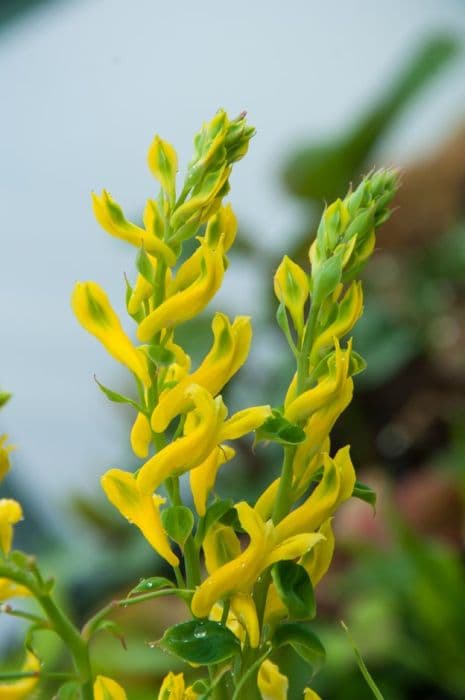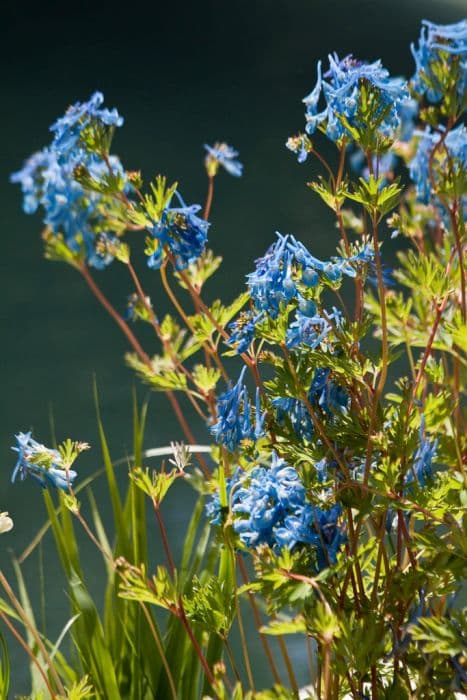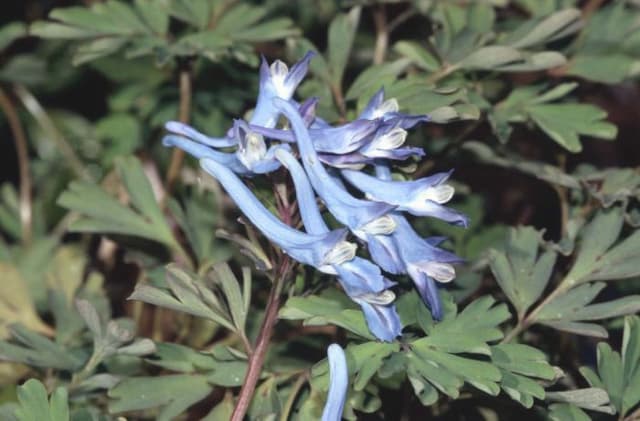Blue corydalis Corydalis flexuosa

ABOUT
C. flexuosa is an herbaceous perennial to 30cm in height, dying down in summer, with divided glaucous leaves, sometimes tinged purple, and clusters of two-lipped blue flowers with white throats in spring and early summer
About this plant
 Names
NamesFamily
Papaveraceae
Synonyms
Blue Corydalis, Chinese Corydalis, Crested Lark, Golden Smoke, Pere David's Corydalis
Common names
Corydalis flexuosa
 Characteristics
CharacteristicsLife cycle
Perennials
Foliage type
Deciduous
Color of leaves
Green
Flower color
Blue
Height
1 foot [30 cm]
Spread
1 foot [30 cm]
Plant type
Herb
Hardiness zones
5
Native area
China
Benefits
 General Benefits
General Benefits- Aesthetic Appeal: Corydalis flexuosa, commonly known as 'Blue Panda', adds striking blue or purple flowers to gardens, which can enhance the visual interest and beauty of the landscape.
- Habitat for Wildlife: The flowers of the Blue Panda can attract beneficial insects such as bees and butterflies, thereby supporting local biodiversity.
- Shade Tolerance: Blue Panda is known for its ability to thrive in shady spots where other plants might struggle, providing gardeners with more planting options.
- Low Maintenance: This plant is relatively easy to care for, requiring minimal maintenance, which can save time and effort for gardeners.
- Seasonal Interest: Blue Panda has a unique flowering time in late spring to early summer, offering seasonal interest during a time when many other plants have not yet started to bloom or have already finished.
- Natural Groundcover: With its spreading habit, it can be used effectively as a groundcover to help control erosion and suppress weed growth.
 Medical Properties
Medical Properties- Analgesic: Corydalis flexuosa contains alkaloids that may have pain-relieving properties.
- Neuroprotective: Some studies suggest that components within Corydalis flexuosa can offer protection for the nervous system.
- Sedative: It is occasionally used for its mild tranquilizing effects to help with sleep disturbances.
- Anxiolytic: The plant may have compounds that could potentially have anti-anxiety effects.
 Air-purifying Qualities
Air-purifying QualitiesThis plant is not specifically known for air purifying qualities.
 Other Uses
Other Uses- Corydalis flexuosa, commonly known as Blue corydalis, can sometimes be used in art projects, specifically in botanical illustration and photography, due to its attractive blue flowers and fern-like foliage.
- In a garden setting, Blue corydalis is effective for filling in gaps between stones in a rock garden, where its roots can delve into crevices and the plant can add both color and texture.
- The plant may be cultivated for use in floral arrangements, providing delicate sprays of blue that complement other flowers, though its longevity once cut may vary.
- Blue corydalis can serve as a teaching tool in educational settings, such as schools or botanical gardens, where students can learn about plant biology and the ecology of shade-loving species.
- Its unique blue coloring can be inspirational in landscape design, influencing color themes and planting combinations in both public and private gardens.
- Gardeners might use this plant in themed gardens, such as 'blue gardens' or 'woodland gardens', to create a specific aesthetic or to reconstruct a particular habitat.
- Ecologically, Blue corydalis can be used in habitat restoration projects, particularly in areas where native ground cover is desired to prevent soil erosion.
- It could be used as a natural dye source for textiles, although there's sparse information on this use; the results and methods would need experimenting to achieve best outcomes.
- Blue corydalis leaves and flowers can sometimes be used in crafts, such as pressed flower art, due to their ornate shapes and colors.
- In a sensory garden, Blue corydalis can provide not only visual aesthetics but also a delicate fragrance to enhance the sensory experience.
Interesting Facts
 Feng Shui
Feng ShuiThe Blue Corydalis is not used in Feng Shui practice.
 Zodiac Sign Compitability
Zodiac Sign CompitabilityThe Blue Corydalis is not used in astrology practice.
 Plant Symbolism
Plant Symbolism- Tranquility: Corydalis flexuosa, also known as Blue Corydalis, is often associated with calmness and peace due to its delicate blue flowers, which can create a serene atmosphere in gardens.
- Adaptability: Blue Corydalis is able to thrive in a variety of soil conditions, symbolizing flexibility and the ability to adapt to different environments and situations in life.
- Hope: The early flowering of Blue Corydalis in spring can symbolize hope and the promise of new beginnings, as it is one of the first plants to bloom after the winter.
 Water
WaterBlue corydalis should be watered deeply but infrequently to ensure that the soil remains moist but not waterlogged. As a woodland plant, it prefers consistently moist soil, so it's vital to check the soil's moisture level before watering. During the growing season in spring and summer, watering may be necessary weekly, with about 1 gallon of water per plant, depending on weather conditions and soil drainage. Cut back on watering in the fall and almost completely withhold water in the winter when the plant is dormant.
 Light
LightBlue corydalis thrives in dappled shade, similar to its native woodland environment. The best spot for this plant is in partial to full shade, avoiding direct afternoon sunlight which can be too harsh and may scorch the leaves. This plant will appreciate a location that mimics the light conditions of a forest understory.
 Temperature
TemperatureBlue corydalis prefers cool temperatures and may struggle in areas with hot summers. This plant is winter-hardy and can withstand temperatures as low as 20 degrees Fahrenheit, but it is best grown where summer temperatures do not consistently exceed 75 degrees Fahrenheit. The ideal temperature range for this plant is between 50 to 70 degrees Fahrenheit.
 Pruning
PruningPruning blue corydalis is typically not required; however, if necessary, it can be done to remove any damaged or spent foliage, especially after flowering. The best time for pruning is in late winter or early spring before new growth starts. Prune sparingly, only to maintain plant shape and health, and avoid cutting back more than a third of the plant at any one time.
 Cleaning
CleaningAs needed
 Soil
SoilBlue corydalis (Corydalis flexuosa) thrives best in moist, well-drained soil with high organic content. A mixture of loam, peat moss, and a handful of coarse sand can create the ideal soil for this plant. The optimal soil pH for blue corydalis is slightly acidic to neutral, ranging from 6.0 to 7.0.
 Repotting
RepottingBlue corydalis typically does not require frequent repotting due to its delicate root system. It should be repotted only when it has outgrown its container or the soil has deteriorated, which may be every 2-3 years.
 Humidity & Misting
Humidity & MistingBlue corydalis prefers high humidity levels, which should be maintained around 50-60% for optimal growth. This plant appreciates a humid environment but is adaptable to typical household levels if not too dry.
 Suitable locations
Suitable locationsIndoor
Place blue corydalis near a window with filtered light and ensure high humidity.
Outdoor
Plant blue corydalis in partial shade with moist, rich soil.
Hardiness zone
5-7 USDA
 Life cycle
Life cycleCorydalis flexuosa, commonly known as Blue Corydalis, begins its life cycle as a seed, often dispersed by ants which are attracted to the seed's fleshy appendage. Upon germination in early spring, the seed grows into a seedling, quickly developing true leaves and a root system. The plant forms a rosette of leaves at ground level, from which flowering stems arise, bearing attractive blue or purplish flowers. After pollination by insects, the flowers develop into elongated seed capsules that burst open when ripe, dispersing the new seeds. In summer, the above-ground parts of Blue Corydalis die back, and the plant goes into a dormancy phase, surviving as tuberous roots. Next spring, the tubers give rise to new foliage, completing the cycle by regenerating the plant for the next flowering season.
 Propogation
PropogationPropogation time
Spring-summer
The Blue Panda Corydalis, which is another name for Corydalis flexuosa, is commonly propagated through division. The best time to propagate by division is in the spring when the plant has broken dormancy and the new growth is visually evident, but is still easily manageable. To propagate the Blue Panda Corydalis, carefully dig up the entire plant, trying to keep the root ball intact. Gently tease apart the root mass to create smaller clumps, each with several shoots and a healthy portion of roots. Replant the divisions immediately at the same depth they were previously growing, spacing them about 12 inches (approximately 30 centimeters) apart to allow for mature spread. Water the new divisions thoroughly after planting to help establish them in their new locations. It is advantageous to maintain moist, well-drained soil conditions and provide light shade, as this mimics the plant's native woodland habitat.









